Door closer mechanism for hot/cold aisle air containment room
Krietzman , et al.
U.S. patent number 10,362,695 [Application Number 15/419,323] was granted by the patent office on 2019-07-23 for door closer mechanism for hot/cold aisle air containment room. This patent grant is currently assigned to Chatsworth Products, Inc.. The grantee listed for this patent is CHATSWORTH PRODUCTS, INC.. Invention is credited to William Krietzman, Richard Evans Lewis, II.
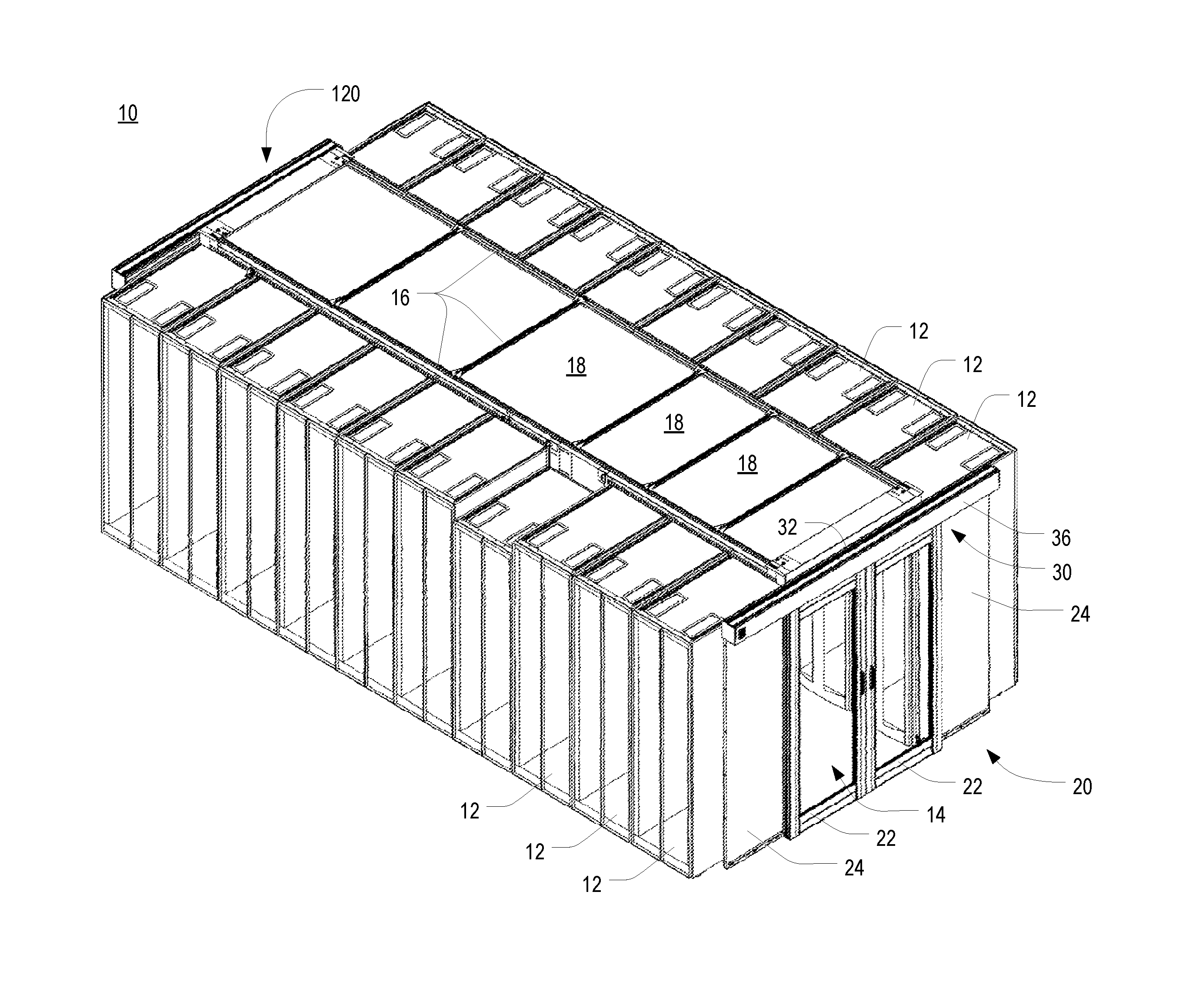
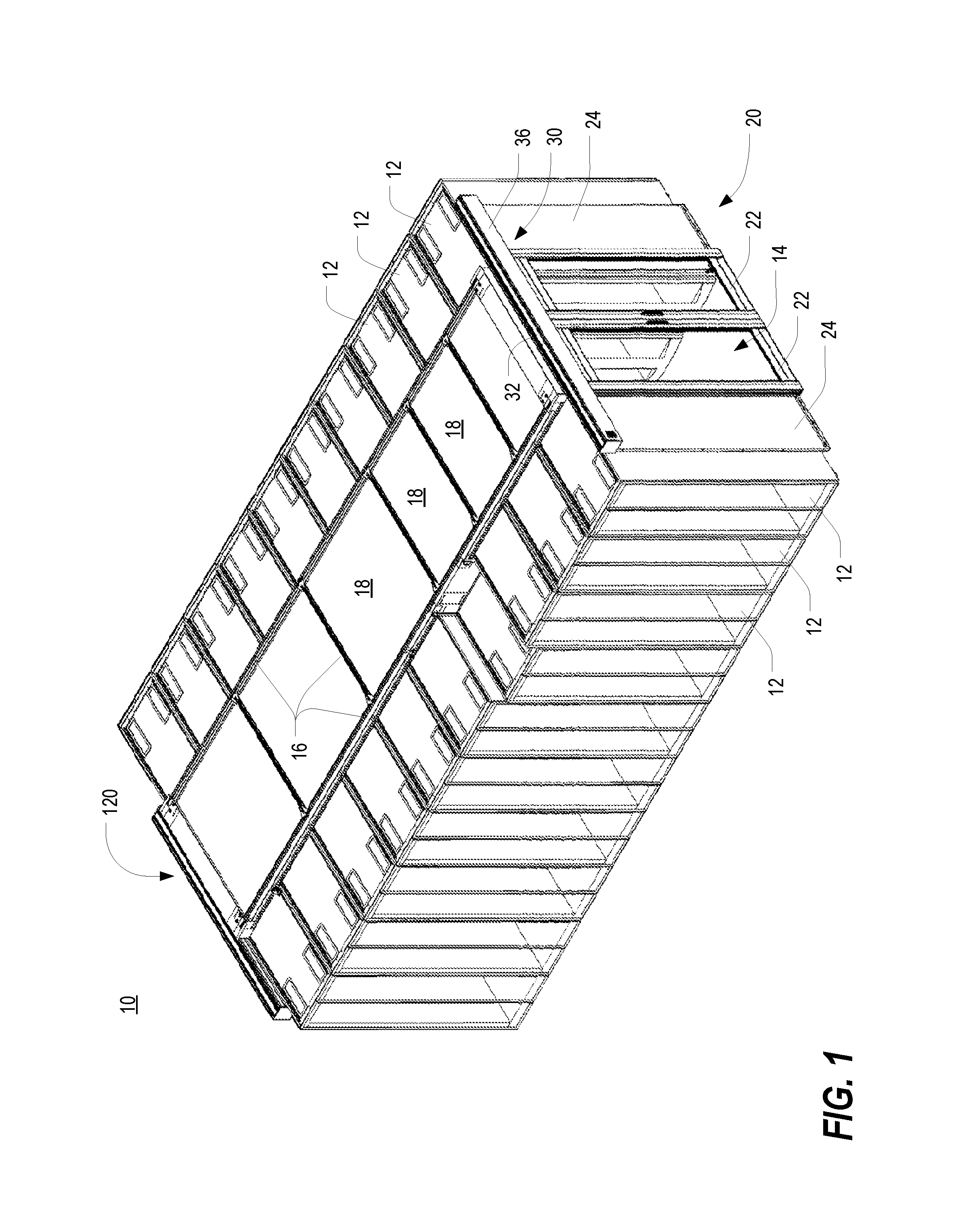
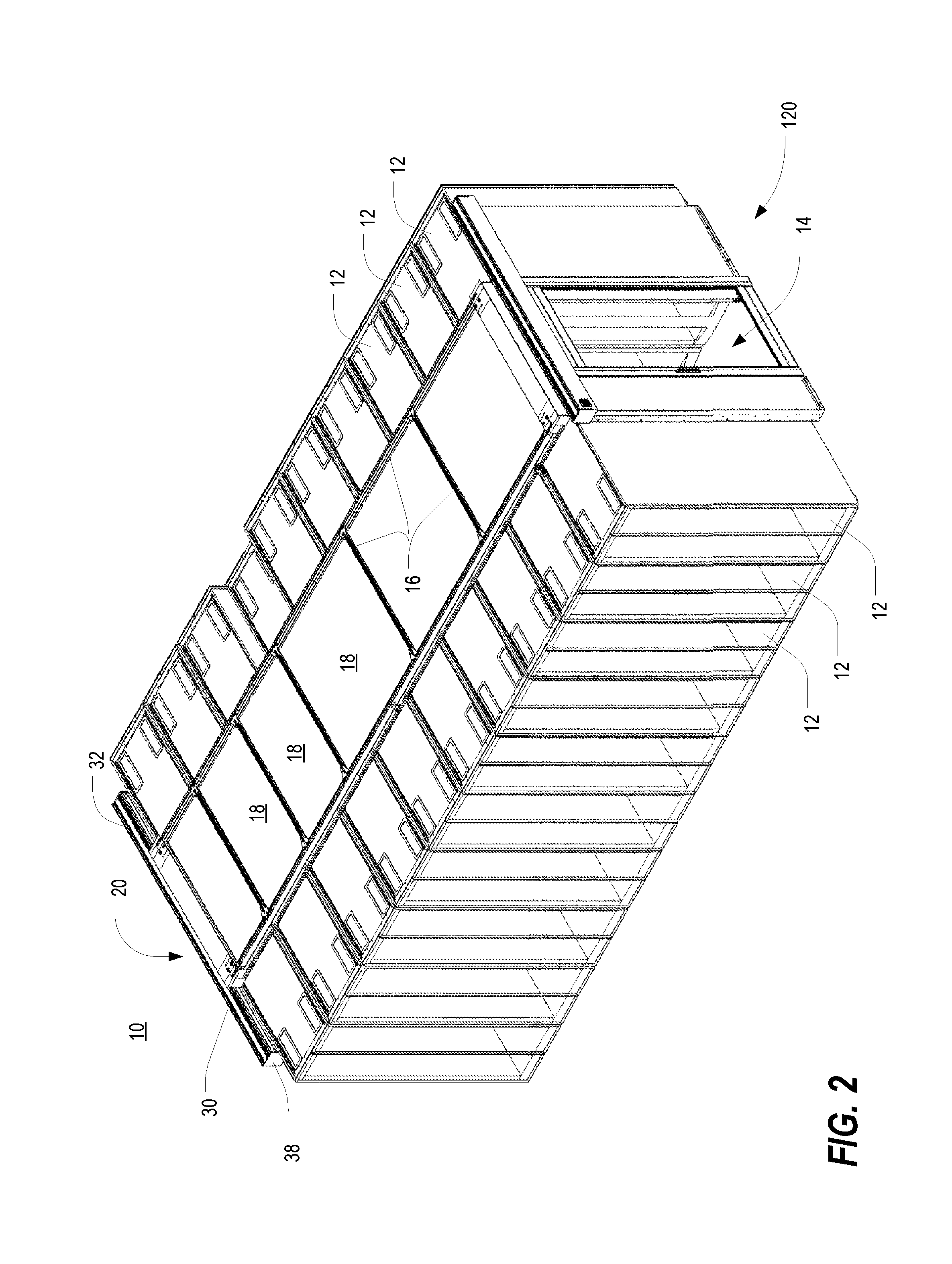
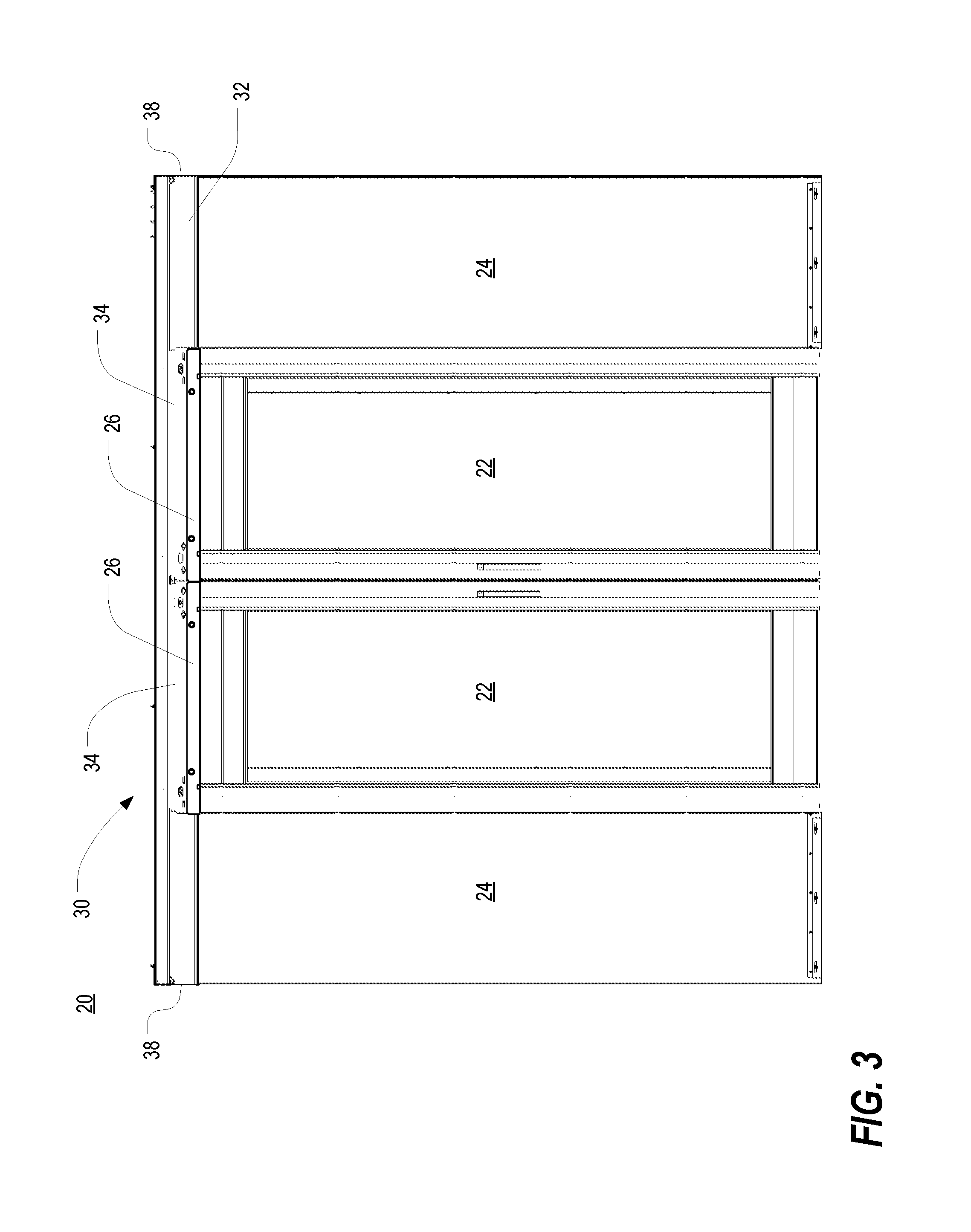
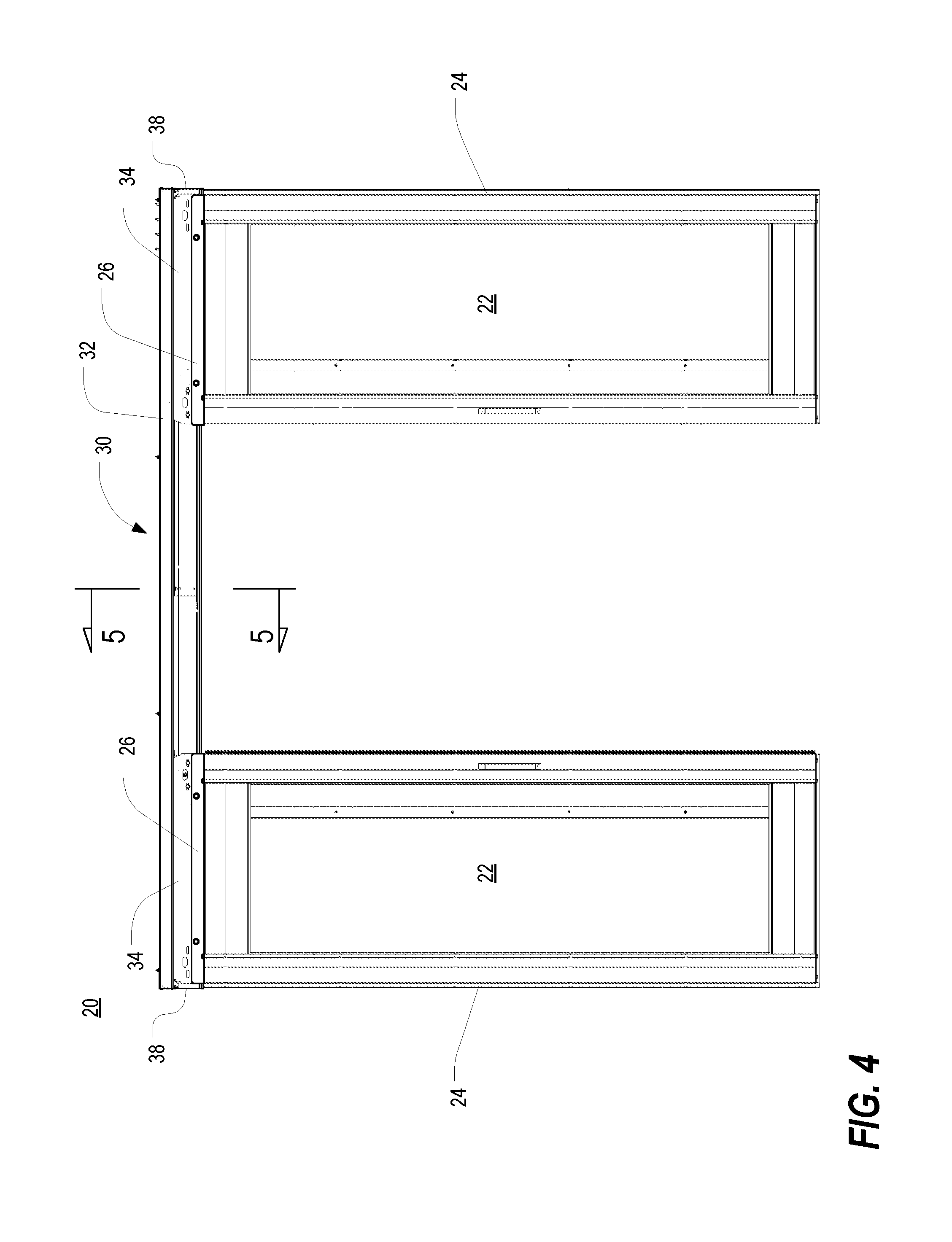

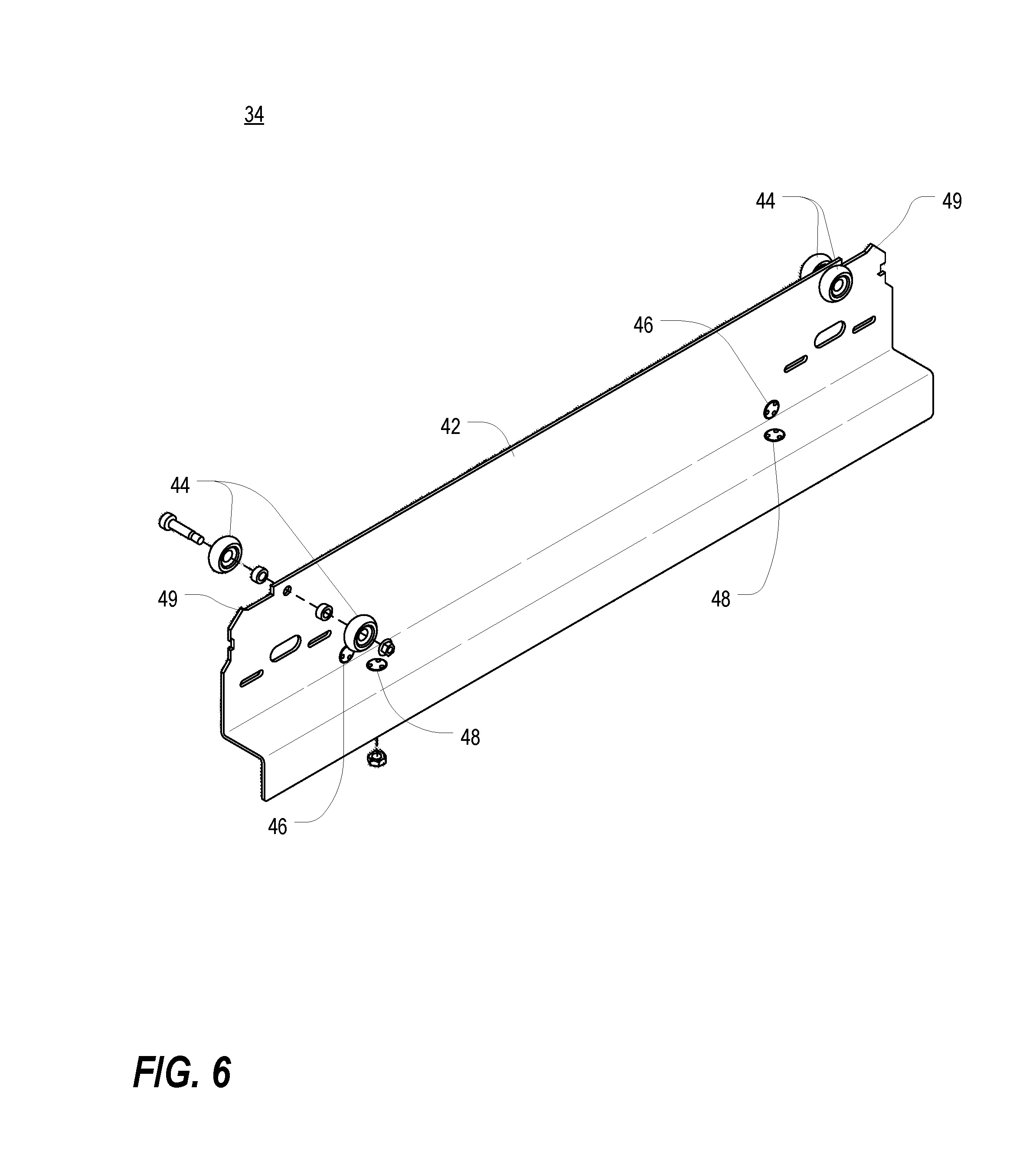
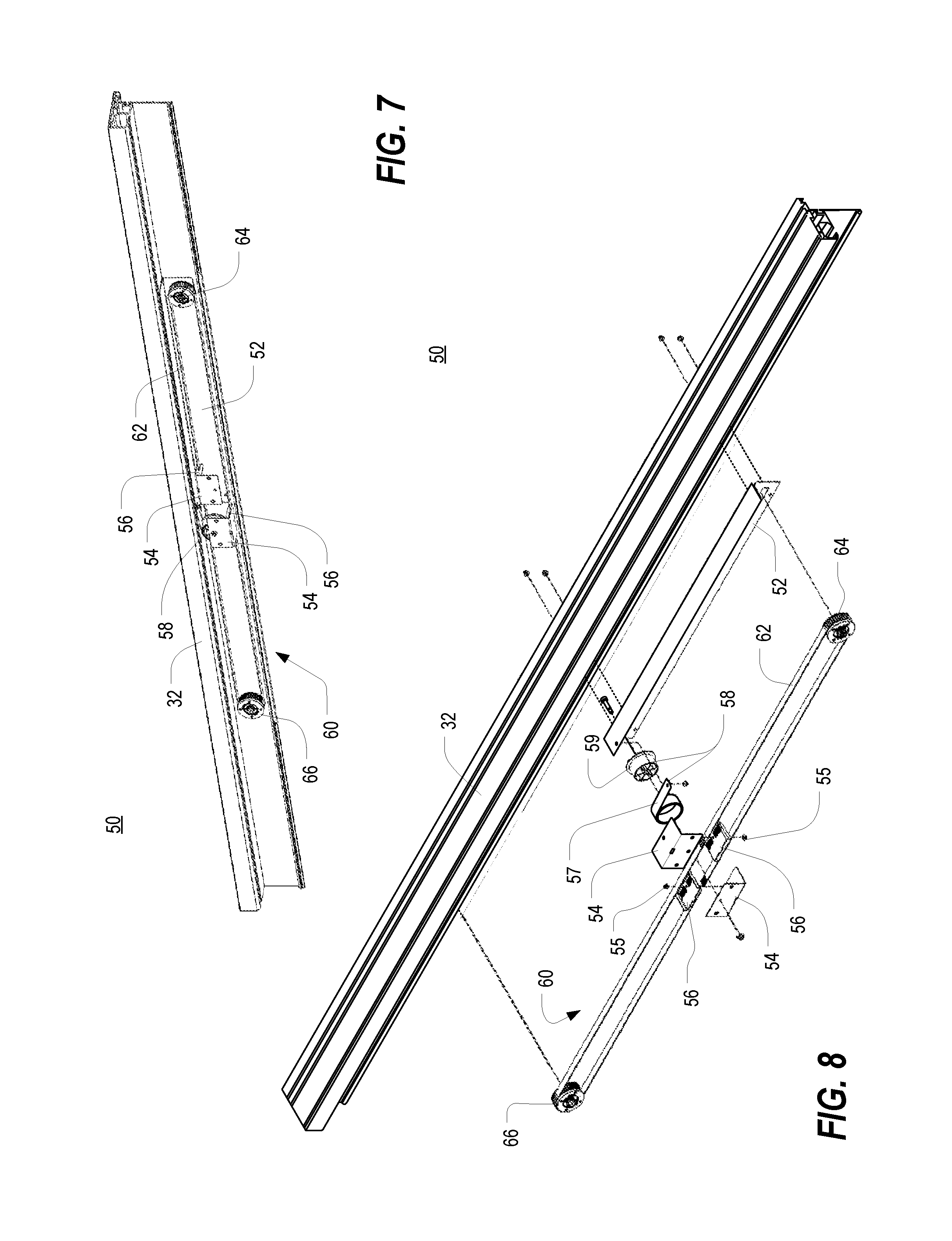


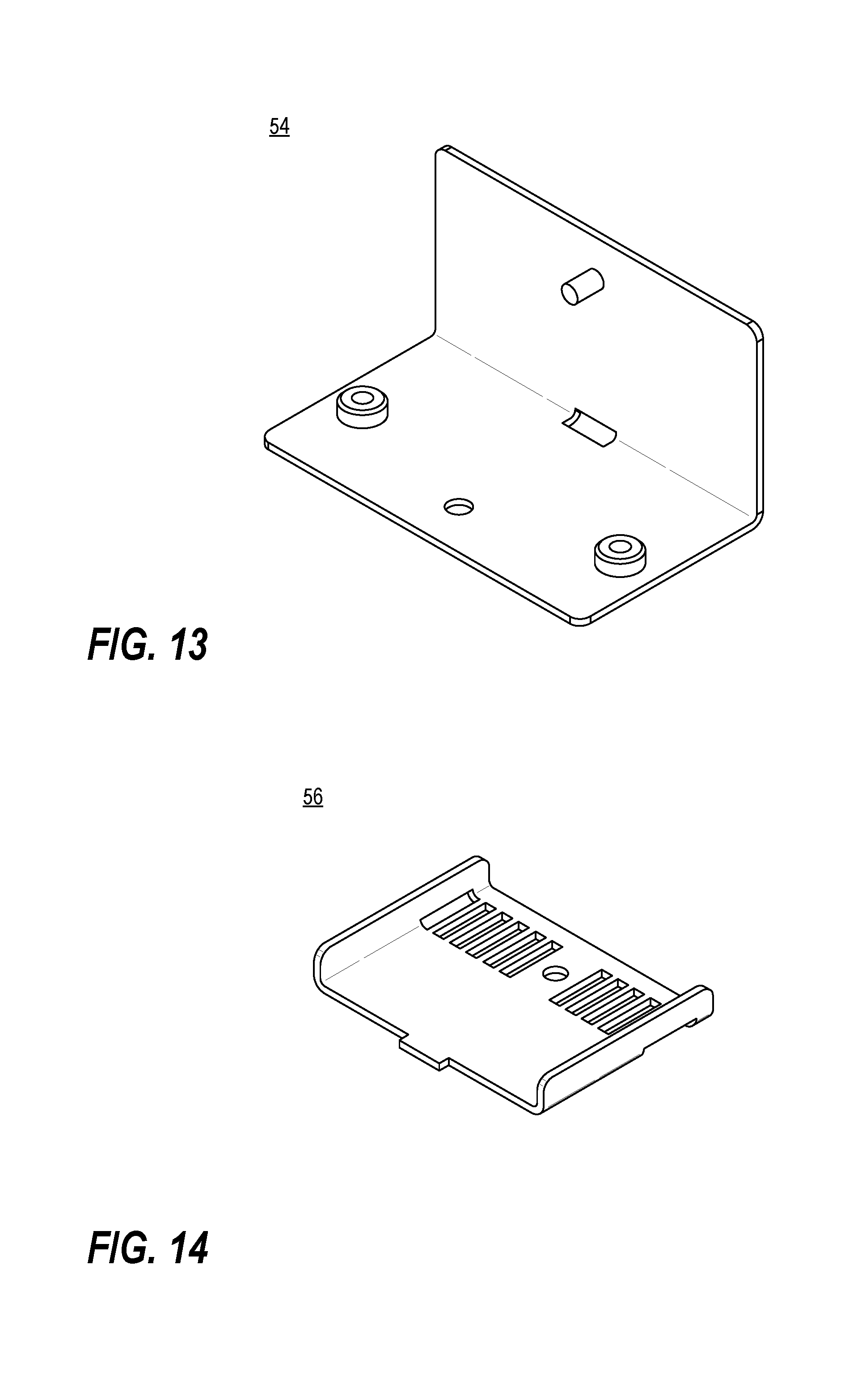
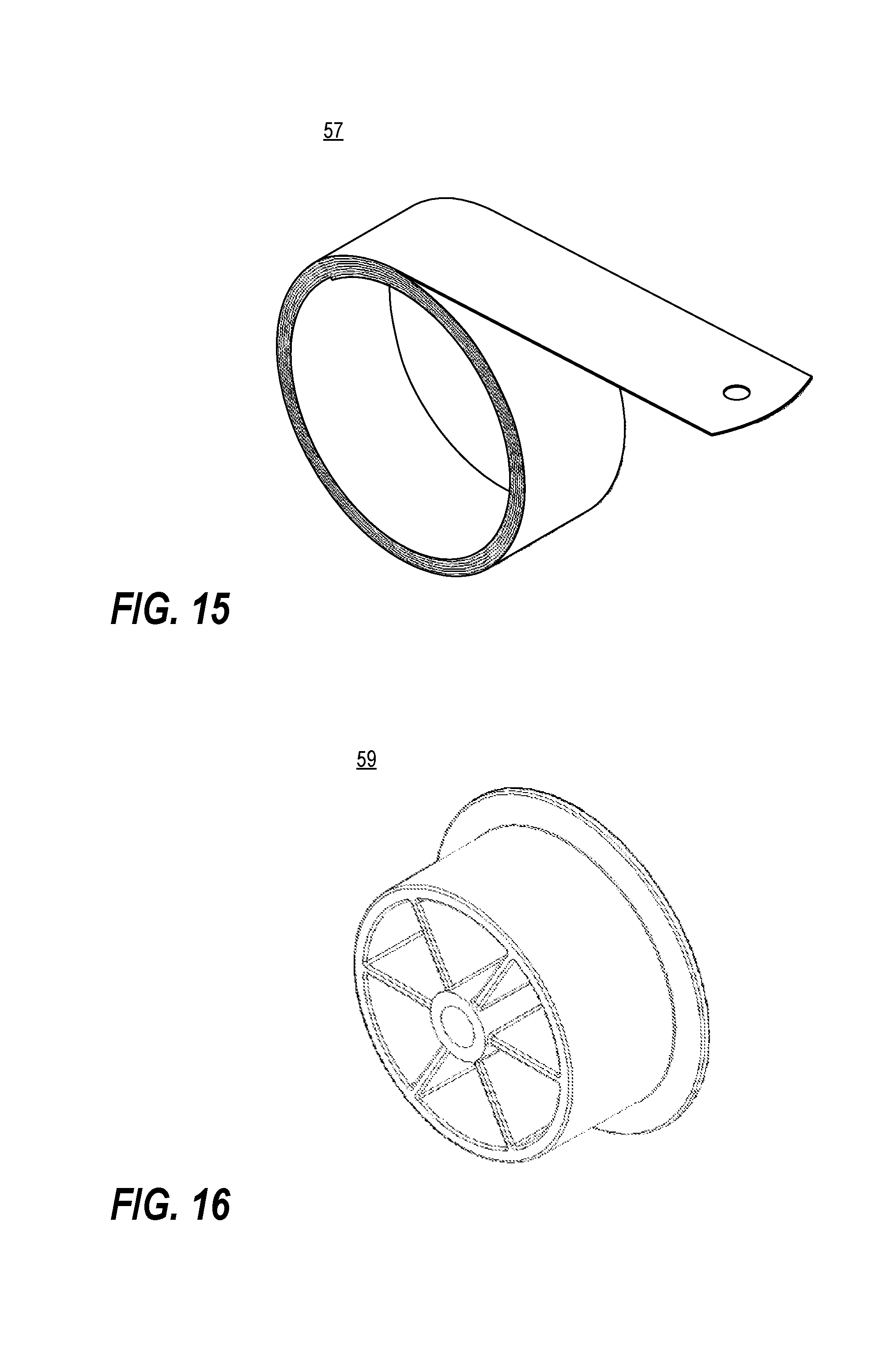
View All Diagrams
| United States Patent | 10,362,695 |
| Krietzman , et al. | July 23, 2019 |
Door closer mechanism for hot/cold aisle air containment room
Abstract
A hot/cold aisle air containment room includes a plurality of electronic equipment enclosures at least partially defining an interior aisle, a frame structure supporting one or more ceiling panels above the interior aisle, and a door assembly. The door assembly includes a sliding door and an unpowered door closer mechanism adapted to move the sliding door from an open state to a closed state, thereby providing controlled access to the interior aisle and minimizing intermixing of hot air and cold air between an environment external to the hot/cold aisle air containment room and an environment internal to the hot/cold aisle air containment room.
| Inventors: | Krietzman; William (Castle Rock, CO), Lewis, II; Richard Evans (Austin, TX) | ||||||||||
|---|---|---|---|---|---|---|---|---|---|---|---|
| Applicant: |
|
||||||||||
| Assignee: | Chatsworth Products, Inc.
(Agoura Hills, CA) |
||||||||||
| Family ID: | 48945961 | ||||||||||
| Appl. No.: | 15/419,323 | ||||||||||
| Filed: | January 30, 2017 |
Prior Publication Data
| Document Identifier | Publication Date | |
|---|---|---|
| US 20170142851 A1 | May 18, 2017 | |
Related U.S. Patent Documents
| Application Number | Filing Date | Patent Number | Issue Date | ||
|---|---|---|---|---|---|
| 13763708 | Feb 10, 2013 | 9560777 | |||
| 61597301 | Feb 10, 2012 | ||||
| Current U.S. Class: | 1/1 |
| Current CPC Class: | H05K 5/0213 (20130101); H05K 7/20745 (20130101); H05K 7/1497 (20130101); H05K 5/0239 (20130101) |
| Current International Class: | H05K 5/00 (20060101); H05K 7/20 (20060101); H05K 7/14 (20060101); H05K 5/02 (20060101) |
| Field of Search: | ;454/184 |
References Cited [Referenced By]
U.S. Patent Documents
| 2424217 | July 1947 | Bales |
| 2766861 | October 1956 | Abramson |
| 3034844 | May 1962 | Anderson et al. |
| 3374821 | March 1968 | White |
| 3889419 | June 1975 | Maleck |
| 4004372 | January 1977 | Beard et al. |
| 4235494 | November 1980 | Chu et al. |
| 4330960 | May 1982 | Hasemann et al. |
| 4372005 | February 1983 | Inesso |
| 4495234 | January 1985 | Tominaga et al. |
| 4502609 | March 1985 | Christatos |
| 4620392 | November 1986 | Kerpers et al. |
| 4757642 | July 1988 | Hahn |
| 4901202 | February 1990 | Leschinger |
| 5187836 | February 1993 | Kim et al. |
| 5294748 | March 1994 | Schwenk et al. |
| 5488543 | January 1996 | Mazura et al. |
| 5829197 | November 1998 | Oh |
| 5848500 | December 1998 | Kirk |
| 5957506 | September 1999 | Stepp |
| 5997117 | December 1999 | Krietzman |
| 6006925 | December 1999 | Sevier |
| 6044193 | March 2000 | Szentesi et al. |
| 6065612 | May 2000 | Rinderer |
| 6079162 | June 2000 | Hein |
| 6123400 | September 2000 | Nicolai et al. |
| 6223479 | May 2001 | Stockli |
| 6225904 | May 2001 | Jaffe et al. |
| 6348655 | February 2002 | Wright |
| 6373721 | April 2002 | Lecinski et al. |
| 6425488 | July 2002 | Notohardjono et al. |
| 6425648 | July 2002 | Notohardjono et al. |
| 6481160 | November 2002 | Kowalczyk |
| 6515225 | February 2003 | Wright |
| 6517174 | February 2003 | Sevier |
| 6527351 | March 2003 | Sevier et al. |
| 6561602 | May 2003 | Sevier et al. |
| 6613981 | September 2003 | Hathcock et al. |
| 6691465 | February 2004 | Stephan |
| 6695149 | February 2004 | Cote et al. |
| 6712434 | March 2004 | Knab et al. |
| 6755493 | June 2004 | Krietzman et al. |
| 6762360 | July 2004 | Wright |
| 6788535 | September 2004 | Dodgen et al. |
| 6802154 | October 2004 | Holt et al. |
| 6814244 | November 2004 | Hathcock |
| 6859366 | February 2005 | Fink |
| 6945616 | September 2005 | Webster et al. |
| 6980433 | December 2005 | Fink |
| 7046514 | May 2006 | Fink et al. |
| 7074123 | July 2006 | Bettridge et al. |
| 7142765 | November 2006 | Rapp et al. |
| 7144320 | December 2006 | Turek et al. |
| 7145772 | December 2006 | Fink |
| 7173820 | February 2007 | Fink et al. |
| 7178292 | February 2007 | Yamada |
| 7226353 | June 2007 | Bettridge et al. |
| 7255640 | August 2007 | Aldag et al. |
| 7259963 | August 2007 | Germagian et al. |
| 7268998 | September 2007 | Ewing et al. |
| 7278273 | October 2007 | Whitted et al. |
| 7293666 | November 2007 | Mattlin et al. |
| 7312980 | December 2007 | Ewing et al. |
| 7425678 | September 2008 | Adducci et al. |
| 7427713 | September 2008 | Adducci et al. |
| 7472970 | January 2009 | Bergesch et al. |
| 7476804 | January 2009 | Adducci et al. |
| 7485803 | February 2009 | Adducci et al. |
| 7495169 | February 2009 | Adducci et al. |
| 7498512 | March 2009 | Adducci et al. |
| 7504581 | March 2009 | Adducci et al. |
| 7506768 | March 2009 | Rassmussen et al. |
| 7529086 | May 2009 | Fink et al. |
| 7542287 | June 2009 | Lewis, II et al. |
| 7592541 | September 2009 | Adducci et al. |
| 7608779 | October 2009 | Adducci et al. |
| 7643291 | January 2010 | Mallia et al. |
| 7656660 | February 2010 | Hoeft et al. |
| 7667135 | February 2010 | Adducci et al. |
| 7684193 | March 2010 | Fink et al. |
| 7697285 | April 2010 | Donowho et al. |
| 7718891 | May 2010 | Adducci et al. |
| 7746637 | June 2010 | Donowho et al. |
| 7772489 | August 2010 | Adducci et al. |
| 7781675 | August 2010 | Adducci et al. |
| 7795532 | September 2010 | Walker |
| 7804685 | September 2010 | Krietzman |
| 7816602 | October 2010 | Landry et al. |
| 7824814 | November 2010 | Suzuki et al. |
| 7839635 | November 2010 | Donowho et al. |
| 7878888 | February 2011 | Rasmussen et al. |
| 7880084 | February 2011 | Adducci et al. |
| 7881057 | February 2011 | Fink et al. |
| 7894190 | February 2011 | Davis et al. |
| 7895855 | March 2011 | Gooch |
| 7952869 | May 2011 | Lewis, II et al. |
| 7957139 | June 2011 | Davis et al. |
| 7974105 | July 2011 | Dean, Jr. et al. |
| 8035965 | October 2011 | Adducci et al. |
| 8040673 | October 2011 | Krietzman |
| 8087979 | January 2012 | Rasmussen |
| 8107238 | January 2012 | Krietzman et al. |
| 8237052 | August 2012 | Adducci et al. |
| 8395046 | March 2013 | Nicewicz et al. |
| 8403736 | March 2013 | Rasmussen et al. |
| 8405984 | March 2013 | Donowho et al. |
| 8411465 | April 2013 | Dean, Jr. et al. |
| 8437147 | May 2013 | Dean, Jr. et al. |
| 8459756 | June 2013 | Linhares et al. |
| 8523643 | September 2013 | Roy |
| 8628158 | January 2014 | Caveney |
| 8653363 | February 2014 | Behrens et al. |
| 8701737 | April 2014 | Mainers et al. |
| 8730665 | May 2014 | Lewis, II et al. |
| 8737068 | May 2014 | Krietzman et al. |
| 8787023 | July 2014 | Lewis, II et al. |
| 8901438 | December 2014 | Lewis, II et al. |
| 9055677 | June 2015 | Garza, Jr. et al. |
| 9072193 | June 2015 | Eichelberg |
| 9072200 | June 2015 | Dersch et al. |
| 9119329 | August 2015 | Krietzman et al. |
| 9204577 | December 2015 | Noteboom et al. |
| 9313927 | April 2016 | Krietzman |
| 9560777 | January 2017 | Krietzman et al. |
| 9585266 | February 2017 | Krietzman et al. |
| 9655259 | May 2017 | North et al. |
| 9781852 | October 2017 | Garza, Jr. et al. |
| 9795060 | October 2017 | Greeson et al. |
| 9955616 | April 2018 | Krietzman et al. |
| 10133320 | November 2018 | Lewis, II et al. |
| 2003/0020379 | January 2003 | Larsen et al. |
| 2004/0183409 | September 2004 | Rinderer |
| 2004/0201335 | October 2004 | Davis |
| 2005/0082021 | April 2005 | Manning |
| 2005/0259383 | November 2005 | Ewing |
| 2006/0103270 | May 2006 | Bergesch et al. |
| 2006/0139877 | June 2006 | Germagian et al. |
| 2006/0141921 | June 2006 | Turek et al. |
| 2006/0260338 | November 2006 | VanGilder et al. |
| 2007/0064389 | March 2007 | Lewis, II et al. |
| 2007/0064391 | March 2007 | Lewis, II et al. |
| 2007/0171613 | July 2007 | McMahan et al. |
| 2007/0183129 | August 2007 | Lewis, II et al. |
| 2007/0210679 | September 2007 | Adducci et al. |
| 2007/0210681 | September 2007 | Adducci et al. |
| 2007/0210683 | September 2007 | Adducci et al. |
| 2007/0210686 | September 2007 | Adducci et al. |
| 2007/0220708 | September 2007 | Lewis |
| 2007/0221393 | September 2007 | Adducci et al. |
| 2007/0293138 | December 2007 | Adducci et al. |
| 2008/0035810 | February 2008 | Lewis, II |
| 2008/0037228 | February 2008 | Lewis, II |
| 2008/0062654 | March 2008 | Mattlin et al. |
| 2008/0067904 | March 2008 | Adducci et al. |
| 2008/0074849 | March 2008 | Adducci et al. |
| 2008/0134745 | June 2008 | Hermanson |
| 2008/0148643 | June 2008 | Lemming |
| 2008/0174217 | July 2008 | Walker |
| 2008/0180004 | August 2008 | Martich et al. |
| 2008/0266789 | October 2008 | Hruby et al. |
| 2008/0316702 | December 2008 | Donowho et al. |
| 2008/0316703 | December 2008 | Donowho et al. |
| 2009/0059523 | March 2009 | Mallia et al. |
| 2009/0129013 | May 2009 | Donowho et al. |
| 2009/0168345 | June 2009 | Martini |
| 2009/0173017 | July 2009 | Hall |
| 2009/0190307 | July 2009 | Krietzman |
| 2009/0227197 | September 2009 | Lewis, II et al. |
| 2009/0239460 | September 2009 | Lucia et al. |
| 2009/0239461 | September 2009 | Lewis, II et al. |
| 2009/0273915 | November 2009 | Dean, Jr. et al. |
| 2009/0277605 | November 2009 | VanGilder et al. |
| 2010/0061059 | March 2010 | Krietzman et al. |
| 2010/0172092 | July 2010 | Davis et al. |
| 2010/0172093 | July 2010 | Davis et al. |
| 2010/0188816 | July 2010 | Bean et al. |
| 2010/0304657 | December 2010 | Gallmann et al. |
| 2010/0307716 | December 2010 | Bean et al. |
| 2011/0019362 | January 2011 | Krietzman |
| 2011/0148261 | June 2011 | Donowho et al. |
| 2011/0211328 | September 2011 | Dean, Jr. et al. |
| 2011/0211329 | September 2011 | Dean, Jr. et al. |
| 2011/0271610 | November 2011 | Cottuli et al. |
| 2011/0278999 | November 2011 | Caveney et al. |
| 2011/0287704 | November 2011 | Lewis, II et al. |
| 2011/0290553 | December 2011 | Behrens et al. |
| 2012/0013229 | January 2012 | Krietzman |
| 2012/0062083 | March 2012 | Lewis, II et al. |
| 2012/0062084 | March 2012 | Lewis, II et al. |
| 2012/0062086 | March 2012 | Garza, Jr. et al. |
| 2012/0062091 | March 2012 | Donowho et al. |
| 2012/0063099 | March 2012 | Alaniz et al. |
| 2012/0112612 | May 2012 | Krietzman |
| 2012/0129441 | May 2012 | Peng et al. |
| 2012/0181906 | July 2012 | Caveney |
| 2012/0194999 | August 2012 | Krietzman et al. |
| 2012/0267991 | October 2012 | Adducci et al. |
| 2013/0149954 | June 2013 | North et al. |
| 2013/0160271 | June 2013 | Krietzman et al. |
| 2013/0165035 | June 2013 | Krietzman et al. |
| 2013/0210335 | August 2013 | Krietzman et al. |
| 2014/0132134 | May 2014 | Garza, Jr. et al. |
| 2014/0196394 | July 2014 | Greeson et al. |
| 2015/0250071 | September 2015 | Garza, Jr. et al. |
| 2016/0088773 | March 2016 | Greeson et al. |
| 2016/0249488 | August 2016 | Krietzman |
| 2017/0150652 | May 2017 | Greeson et al. |
| 2017/0231119 | August 2017 | North et al. |
| 2018/0027677 | January 2018 | Garza, Jr. et al. |
| 2018/0035570 | February 2018 | Greeson et al. |
| 2018/0110153 | April 2018 | Hennrich et al. |
| 2018/0242483 | August 2018 | Krietzman et al. |
| 2008254682 | Nov 2012 | AU | |||
| 2205054 | Jul 2010 | EP | |||
| 2429271 | Mar 2012 | EP | |||
| 2429272 | Mar 2012 | EP | |||
| 2366084 | Sep 2002 | GB | |||
| 2006055506 | May 2006 | WO | |||
| 2008022058 | Feb 2008 | WO | |||
| 2008022058 | Nov 2008 | WO | |||
| 2008144678 | Nov 2008 | WO | |||
| 2009089008 | Jul 2009 | WO | |||
| 2009103090 | Aug 2009 | WO | |||
| 2009103090 | Oct 2009 | WO | |||
| 2010028384 | Mar 2010 | WO | |||
| 2010028384 | May 2010 | WO | |||
| 2018022721 | Feb 2018 | WO | |||
Other References
|
Information Disclosure Statement (IDS) Letter Regarding Common Patent Applications(s), dated Jan. 30, 2018. cited by applicant . Information Disclosure Statement (IDS) Letter Regarding Common Patent Application(s), dated Nov. 13, 2017. cited by applicant . Information Disclosure Statement (IDS) Letter Regarding Common Patent Application(s), dated Apr. 26, 2017. cited by applicant . Chatsworth Products, Inc., "Thermal Management Solutions," Signature Solutions Brochure, revision dated Mar. 2008, www.chatsworth.com/passivecooling (6 pages). cited by applicant . OCR, Product Brochure, accessed at www.datacenterinarow.com, on or about Mar. 2011 (25 pages). cited by applicant . Panduit Corporation, Panduit Net-Access Vertical Exhaust System (VES) Specification Sheet, dated Feb. 2011 (4 pages). cited by applicant . Panduit Corporation, Panduit Net-Access Vertical Exhaust Duct (VES) Instructions, dated 2009 (4 pages). cited by applicant . Emerson Network Power, Smart Cooling Solutions Data Center, Oct. 2012, Internet Web Page <http://www.emersonnetworkpower.com/en-EMEA/Products/RACKSANDINTEGRATE- DCABINETS/Documents/Knurr%20DCD/Smart-Cooling-Solutions-Data-Center-EN.pdf- > (51 pages). cited by applicant . Hewlett-Packard Development Company, LP, HP 10000 G2 42U Rack Air Duct Installation Guide, dated Aug. 2008 (23 pages). cited by applicant . Information Disclosure Statement (IDS) Letter Regarding Common Patent Application(s), dated Mar. 8, 2019. cited by applicant. |
Primary Examiner: Kosanovic; Helena
Attorney, Agent or Firm: Tillman Wright, PLLC Wright; James D. Higgins; David R.
Parent Case Text
CROSS-REFERENCE TO RELATED APPLICATIONS
The present application is a U.S. continuation patent application of, and claims priority under 35 U.S.C. .sctn. 120 to, U.S. nonprovisional patent application Ser. No. 13/763,708, filed Feb. 10, 2013 and entitled, "DOOR CLOSER MECHANISM FOR HOT/COLD AISLE AIR CONTAINMENT ROOM," which published on Aug. 15, 2013 as U.S. Patent Application Publication No. US 2013/0210335 A1 and issued as U.S. Pat. No. 9,560,777 on Jan. 31, 2017, which '708 application, the application publication thereof, and the patent issuing therefrom are each expressly incorporated herein by reference in their entirety, and which '708 application is a U.S. nonprovisional patent application of, and claims priority under 35 U.S.C. .sctn. 119(e) to, U.S. provisional patent application Ser. No. 61/597,301, filed Feb. 10, 2012 and entitled, "DOOR CLOSER MECHANISM FOR HOT/COLD AISLE AIR CONTAINMENT ROOM," which '301 application is expressly incorporated herein by reference in its entirety. Additionally, each of the following commonly-assigned U.S. patent applications, including any application publication thereof, is expressly incorporated herein by reference in its entirety: (a) U.S. provisional patent application Ser. No. 61/411,359, filed Nov. 8, 2010 and entitled, "ADJUSTABLE WALL ASSEMBLY FOR HOT/COLD AISLE CONTAINMENT SYSTEM," attached hereto as Appendix A, which itself is expressly incorporated herein by reference in its entirety; (b) U.S. provisional patent application Ser. No. 61/568,692, filed Dec. 9, 2011 and entitled, "DATA PROCESSING EQUIPMENT STRUCTURE;" and (c) U.S. nonprovisional patent application Ser. No. 13/707,521, filed Dec. 6, 2012 and entitled, "DATA PROCESSING EQUIPMENT STRUCTURE," which '521 application published on Jun. 13, 2013 as U.S. Patent Application Publication No. US 2013/0149954 A1.
Claims
What is claimed is:
1. A hot/cold aisle air containment room comprising: a plurality of electronic equipment enclosures arranged in a pair of rows, each row of equipment enclosures defining a respective side of an interior environment of the hot/cold aisle air containment room; a frame structure supporting one or more ceiling panels above the interior environment; and first and second end coverings arranged at respective ends of the interior environment; wherein the plurality of electronic equipment enclosures, the one or more ceiling panels and the first and second end coverings, together, enclose the interior environment and thermally separate the interior environment from an exterior environment external to the hot/cold aisle air containment room; and wherein at least one of the first and second end coverings is a door assembly comprising: a sliding door, and an unpowered door closer mechanism adapted to maneuver the sliding door from an open state to a closed state, thereby providing controlled access to the interior environment and minimizing intermixing of hot air and cold air between the interior environment and the exterior environment wherein the door closer mechanism includes a belt/pulley assembly that comprises a damper pulley, a free pulley, and a belt routed around the damper pulley and the free pulley; and the sliding door is attached to the belt, thereby allowing the sliding door to be controlled relative to the belt.
2. The hot/cold aisle air containment room of claim 1, wherein the interior environment is a cold aisle.
3. The hot/cold aisle air containment room of claim 1, wherein the interior environment is a hot aisle.
4. The hot/cold aisle air containment room of claim 1, wherein the belt is a toothed synchronous belt.
5. The hot/cold aisle air containment room of claim 4, wherein each of the damper pulley and the free pulley includes a cylindrical bearing surface having a series of teeth that interlock with the toothed synchronous belt.
6. The hot/cold aisle air containment room of claim 1, further comprising a pulley tensioning device.
7. The hot/cold aisle air containment room of claim 1, wherein the sliding door is attached to the belt via a splice bracket and a belt splice plate.
8. The hot/cold aisle air containment room of claim 1, wherein the door assembly further comprises a return spring mounted on a spool to provide resistance to the sliding door.
9. The hot/cold aisle air containment room of claim 8, wherein a biasing force of the return spring is resisted by the damper pulley.
10. The hot/cold aisle air containment room of claim 1, wherein the damper pulley is permitted to rotate freely in one direction and is damped in the other direction.
11. The hot/cold aisle air containment room of claim 10, wherein: the damper pulley is permitted to rotate freely when the sliding door is being opened; and the damper pulley is damped when the sliding door is being closed.
12. A hot/cold aisle air containment room comprising: a plurality of electronic equipment enclosures, arranged in a row, the row defining at least one side of an interior aisle; a frame structure supporting one or more ceiling panels above the interior aisle; and a door assembly arranged at an end of the interior aisle, the door assembly comprising: a sliding door; and an unpowered door closer mechanism adapted to maneuver the sliding door from an open state to a closed state; wherein the door closer mechanism includes a belt/pulley assembly having each of a damper pulley, a free pulley, and a belt routed around the damper pulley and the free pulley; and wherein the sliding door is attached to the belt, thereby allowing the sliding door to be controlled relative to the belt.
13. The hot/cold aisle air containment room of claim 12, wherein the belt is a toothed synchronous belt.
14. The hot/cold aisle air containment room of claim 13, wherein each of the damper pulley and the free pulley include a cylindrical bearing surface having a series of teeth that interlock with the toothed synchronous belt.
15. The hot/cold aisle air containment room of claim 12, wherein the damper pulley is permitted to rotate freely in one direction and is damped in the other direction.
16. The hot/cold aisle air containment room of claim 15, wherein: the damper pulley is permitted to rotate freely when the sliding door is being opened; and the damper pulley is damped when the sliding door is being closed.
17. A hot/cold aisle air containment room comprising: a plurality of electronic equipment enclosures, arranged in a row, the row defining at least one side of an interior aisle; a frame structure supporting one or more ceiling panels above the interior aisle; and a door assembly arranged at an end of the interior aisle, the door assembly comprising: a sliding door; and an unpowered door closer mechanism adapted to move the sliding door from an open state to a closed state; wherein the door closer mechanism includes a belt/pulley assembly supported by a rail assembly, the rail assembly including a main rail extrusion that supports at least one roller bracket assembly; and wherein each roller bracket assembly includes at least one roller that rides along a portion of the main rail extrusion and that supports a roller bracket which supports the sliding door.
18. The hot/cold aisle air containment room of claim 17, wherein the at least one roller rides in a roller cavity in the main rail extrusion.
19. The hot/cold aisle air containment room of claim 17, wherein: a spring bracket is attached at one end of the rail assembly; and a portion of the at least one roller bracket assembly engages the spring bracket when the sliding door is moved to a fully open state.
20. The hot/cold aisle air containment room of claim 19, wherein the at least one roller bracket assembly is disengageable from the spring bracket by pulling the door closed.
Description
COPYRIGHT STATEMENT
All of the material in this patent document is subject to copyright protection under the copyright laws of the United States and other countries. The copyright owner has no objection to the facsimile reproduction by anyone of the patent document or the patent disclosure, as it appears in official governmental records but, otherwise, all other copyright rights whatsoever are reserved.
BACKGROUND OF THE PRESENT INVENTION
Field of the Present Invention
The present invention relates generally to door assemblies for electronic equipment hot/cold aisle air containment rooms, and, in particular, to door assemblies having a door closer mechanism.
Background
Racks, frames and enclosures for mounting and storing computer and other electronic components or equipment have been well known for many years. Racks and frames are typically simple rectangular frameworks on which electronic components may be mounted, or on which other mounting members, such as shelves or brackets, may be mounted which in turn may support the electronic components. Enclosures are typically frames on which panels or doors, or both, are hung to provide aesthetic improvement, to protect the components from external influences, to provide security for the components stored inside, or for other reasons.
Racks, frames and enclosures have been built in many different sizes and with many different proportions in order to best accommodate the components which they are designed to support and store. Components stored in these enclosures may include audio and video equipment and the like, but quite frequently include computer equipment and related peripheral devices. These components typically include housings enclosing internal operative elements.
As is also well known, the electronic equipment mounted in these structures tends to generate large amounts of thermal energy that needs to be exhausted away from the equipment effectively in order to maintain the equipment in proper operating order or to prevent damage thereto. The problem can be especially significant when the components are enclosed in enclosures, because thermal energy generated thereby can concentrate within the equipment enclosure and cause the components to overheat and shut down. As equipment becomes more densely packed with electronics, the quantities of thermal energy have continued to increase in recent years, and thermal energy management has become a significant issue confronting today's rack, enclosure, frame and enclosure manufacturers, the manufacturers of the electronic equipment, and the users of such equipment.
Typically, multiple racks, frames, enclosures, and the like (sometimes collectively referred to hereinafter as "enclosures") are housed together in a data center room. Because of the overheating problem, and particularly with multiple enclosures being placed in a single room, thermal management of the data center room is very important. A goal of data center thermal management is to maximize the performance, uptime and life expectancy of the active components being housed in the room. Toward this end, data center rooms are often arranged so as to increase efficiency and optimize performance.
One common way of organizing a data center room to meet these objectives involves arranging individual enclosures in rows, with the air intake of each enclosure facing toward one side of the row and the heated air exhaust of each enclosure facing toward the other side of the row. Rows of enclosures are arranged in back-to-back relationship so that enclosures of two separate rows receive cool intake air from a common "cold" aisle between the rows, exhaust heated air into a common "hot" aisle between the rows, or utilize a combination thereof. Various permutations of these arrangements are well known.
When "cold" or "hot" aisle approaches are utilized, they must still accommodate human access into the aisle so as to access the enclosures themselves. In older implementations, no special walls or other structures are utilized to maximize separation of the aisles from the environment, but more recently, the cold and hot aisle effect has been enhanced through the use of such structures. In these implementations, it has become more necessary to provide doors for access to the interior of the aisles. This, in turn, has created a need for improvements in door assemblies to address such issues as doors being left open accidentally, but without creating additional power requirements. This and other needs are addressed by the present invention.
SUMMARY OF THE PRESENT INVENTION
The present invention comprises a hot/cold aisle air containment room. Broadly defined, the present invention according to a first aspect includes a hot/cold aisle air containment room substantially as shown and described.
Broadly defined, the present invention according to a second aspect includes a hot/cold aisle air containment room, having a door closer mechanism, substantially as shown and described.
Broadly defined, the present invention according to a third aspect includes a hot/cold aisle air containment room that includes a pair of rows of electronic equipment enclosures defining an interior aisle therebetween, a frame structure supporting one or more ceiling panels above the interior aisle, and a door assembly. The door assembly includes one or more doors and has a door closer mechanism to provide controlled access to the interior aisle.
In features of this aspect, the interior aisle may be a cold aisle; and/or the interior aisle may be a hot aisle.
In further features of this aspect, the door closer mechanism may include a belt/pulley assembly supported by a rail extrusion of the door assembly; the belt/pulley assembly may include a damper pulley, a free pulley, and a timing belt routed around the damper pulley and the free pulley; the timing belt may be toothed; each of the damper pulley and the free pulley may include a cylindrical bearing surface having a series of teeth that interlock with the toothed timing belt; the one or more doors may be attached to the timing belt via a splice bracket and a belt splice plate, thereby allowing the one or more doors to be controlled relative to the timing belt; the door assembly may further include a return spring mounted on a spool to provide resistance to the one or more doors; a biasing force of the return spring may be resisted by the damper pulley; the damper pulley may be permitted to rotate freely in one direction and is damped in the other direction; the damper pulley may be permitted to rotate freely when the one or more doors are being opened; and/or the damper pulley may be damped when the one or more doors are being closed.
Broadly defined, the present invention according to a fourth aspect includes a method of opening and closing one or more doors in a hot/cold aisle air containment room, substantially as shown and described.
Broadly defined, the present invention according to a fifth aspect includes a hot/cold aisle air containment room. The hot/cold aisle air containment room includes a plurality of electronic equipment enclosures at least partially defining an interior aisle, a frame structure supporting one or more ceiling panels above the interior aisle, and a door assembly. The door assembly includes a sliding door and am unpowered door closer mechanism adapted to move the sliding door from an open state to a closed state, thereby providing controlled access to the interior aisle and minimizing intermixing of hot air and cold air between an environment external to the hot/cold aisle air containment room and an environment internal to the hot/cold aisle air containment room.
In features of this aspect, the hot/cold aisle air containment room may be disposed within a room in a building; the interior aisle may be a cold aisle; and/or the interior aisle may be a hot aisle.
In further features of this aspect, the plurality of electronic equipment enclosures may be arranged in a row, wherein the interior aisle includes two sides and two ends, and wherein the row of electronic equipment enclosures defines one side of the interior aisle; and/or the plurality of electronic equipment enclosures may be arranged in a pair of rows, and wherein the pair of rows of electronic equipment enclosures define opposite sides of the interior aisle.
In further features of this aspect, the hot/cold aisle air containment room may further include one or more wall panels; the wall panels may at least partially define at least one end or side of the interior aisle; and/or the wall panels may be a part of the door assembly.
In further features of this aspect, the door assembly may be disposed at one end of the interior aisle; the sliding door may be a first sliding door, wherein the door assembly includes a second sliding door, and wherein the unpowered door closer mechanism is adapted to move the first sliding door and the second sliding door simultaneously from an open state to a closed state; and/or the door closer mechanism may include a belt/pulley assembly supported by a rail assembly.
In further features of this aspect, the belt/pulley assembly may include a damper pulley, a free pulley, and a belt routed around the damper pulley and the free pulley, wherein the sliding door is attached to the belt, thereby allowing the sliding door to be controlled relative to the belt; the belt may be a synchronous belt; the synchronous belt may be toothed; and/or each of the damper pulley and the free pulley may include a cylindrical bearing surface having a series of teeth that interlock with the toothed synchronous belt.
In further features of this aspect, the hot/cold aisle air containment room may further include a pulley tensioning device; the sliding door may be attached to the belt via a splice bracket and a belt splice plate; the door assembly may further include a return spring mounted on a spool to provide resistance to the sliding door; and/or a biasing force of the return spring may be resisted by the damper pulley.
In further features of this aspect, the damper pulley may be permitted to rotate freely in one direction and is damped in the other direction; the damper pulley may be permitted to rotate freely when the sliding door is being opened; and/or the damper pulley may be damped when the sliding door is being closed.
In further features of this aspect, the rail assembly may include a main rail extrusion supporting at least one roller bracket assembly; each roller bracket assembly may include at least one roller that rides along a portion of the main rail extrusion and that supports a roller bracket which supports the sliding door; and/or the at least one roller may ride in a roller cavity in the main rail extrusion.
In still further features of this aspect, a spring bracket may be attached at one end of the rail assembly, wherein a structure is provided that engages the spring bracket when the sliding door is moved to a fully open state; the structure may be disengageable from the spring bracket by pulling the door closed; and/or the hot/cold aisle air containment room may further include a roller bracket assembly that carries the door, wherein the structure is a portion of the roller bracket assembly.
Further areas of applicability of the present invention will become apparent from the detailed description provided hereinafter. It should be understood that the detailed description and specific examples, while indicating the preferred embodiment of the invention, are intended for purposes of illustration only and are not intended to limit the scope of the invention.
BRIEF DESCRIPTION OF THE DRAWINGS
Further features, embodiments, and advantages of the present invention will become apparent from the following detailed description with reference to the drawings, wherein:
FIG. 1 is a front isometric view of a containment room having a double door assembly with a door closer mechanism in accordance with one or more preferred embodiments of the present invention;
FIG. 2 is a rear isometric view of the containment room of FIG. 1, illustrating a single door assembly with a door closer mechanism in accordance with one or more preferred embodiments of the present invention;
FIG. 3 is a front view of the double door assembly of FIG. 1, shown with the front cover of the rail assembly removed;
FIG. 4 is a front view of the double door assembly of FIG. 3, shown with the doors in an open state;
FIG. 5 is a fragmentary side cross sectional view of the rail assembly of FIG. 4, taken along line 5-5;
FIG. 6 is a partially exploded isometric view of one of the roller bracket assemblies of FIG. 3;
FIG. 7 is an orthogonal view of the door closer mechanism of FIG. 3;
FIG. 8 is an exploded isometric view of the door closer mechanism of FIG. 7;
FIG. 9 is an isometric view of the damper pulley of FIG. 8;
FIG. 10 is an exploded isometric view of the damper pulley of FIG. 9;
FIG. 11 is an isometric view of the free pulley of FIG. 8;
FIG. 12 is an exploded isometric view of the free pulley of FIG. 11;
FIG. 13 is an isometric view of one of the belt splice brackets of FIG. 8;
FIG. 14 is an isometric view of one of the belt splice plates of FIG. 8;
FIG. 15 is an isometric view of the return spring of FIG. 8;
FIG. 16 is an isometric view of the return spring spool of FIG. 8;
FIG. 17 is an exploded fragmentary rear isometric view of portions of the left end of the rail assembly of FIG. 4; and
FIGS. 18 and 19 are enlarged fragmentary front cross-sectional views of the rail assembly of FIG. 5, taken along line 18-18.
DETAILED DESCRIPTION
As a preliminary matter, it will readily be understood by one having ordinary skill in the relevant art ("Ordinary Artisan") that the present invention has broad utility and application. Furthermore, any embodiment discussed and identified as being "preferred" is considered to be part of a best mode contemplated for carrying out the present invention. Other embodiments also may be discussed for additional illustrative purposes in providing a full and enabling disclosure of the present invention. As should be understood, any embodiment may incorporate only one or a plurality of the above-disclosed aspects of the invention and may further incorporate only one or a plurality of the above-disclosed features. Moreover, many embodiments, such as adaptations, variations, modifications, and equivalent arrangements, will be implicitly disclosed by the embodiments described herein and fall within the scope of the present invention.
Accordingly, while the present invention is described herein in detail in relation to one or more embodiments, it is to be understood that this disclosure is illustrative and exemplary of the present invention, and is made merely for the purposes of providing a full and enabling disclosure of the present invention. The detailed disclosure herein of one or more embodiments is not intended, nor is to be construed, to limit the scope of patent protection afforded the present invention, which scope is to be defined by the claims and the equivalents thereof. It is not intended that the scope of patent protection afforded the present invention be defined by reading into any claim a limitation found herein that does not explicitly appear in the claim itself.
Thus, for example, any sequence(s) and/or temporal order of steps of various processes or methods that are described herein are illustrative and not restrictive. Accordingly, it should be understood that, although steps of various processes or methods may be shown and described as being in a sequence or temporal order, the steps of any such processes or methods are not limited to being carried out in any particular sequence or order, absent an indication otherwise. Indeed, the steps in such processes or methods generally may be carried out in various different sequences and orders while still falling within the scope of the present invention. Accordingly, it is intended that the scope of patent protection afforded the present invention is to be defined by the appended claims rather than the description set forth herein.
Additionally, it is important to note that each term used herein refers to that which the Ordinary Artisan would understand such term to mean based on the contextual use of such term herein. To the extent that the meaning of a term used herein--as understood by the Ordinary Artisan based on the contextual use of such term--differs in any way from any particular dictionary definition of such term, it is intended that the meaning of the term as understood by the Ordinary Artisan should prevail.
Regarding applicability of 35 U.S.C. .sctn. 112, 6, no claim element is intended to be read in accordance with this statutory provision unless the explicit phrase "means for" or "step for" is actually used in such claim element, whereupon this statutory provision is intended to apply in the interpretation of such claim element.
Furthermore, it is important to note that, as used herein, "a" and "an" each generally denotes "at least one," but does not exclude a plurality unless the contextual use dictates otherwise. Thus, reference to "a picnic basket having an apple" describes "a picnic basket having at least one apple" as well as "a picnic basket having apples." In contrast, reference to "a picnic basket having a single apple" describes "a picnic basket having only one apple."
When used herein to join a list of items, "or" denotes "at least one of the items," but does not exclude a plurality of items of the list. Thus, reference to "a picnic basket having cheese or crackers" describes "a picnic basket having cheese without crackers," "a picnic basket having crackers without cheese," and "a picnic basket having both cheese and crackers." Finally, when used herein to join a list of items, "and" denotes "all of the items of the list." Thus, reference to "a picnic basket having cheese and crackers" describes "a picnic basket having cheese, wherein the picnic basket further has crackers," as well as describes "a picnic basket having crackers, wherein the picnic basket further has cheese."
Referring now to the drawings, in which like numerals represent like components throughout the several views, one or more preferred embodiments of the present invention are next described. The following description of one or more preferred embodiment(s) is merely exemplary in nature and is in no way intended to limit the invention, its application, or uses.
FIG. 1 is a front isometric view of a containment room 10 having a double door assembly 20 with a door closer mechanism in accordance with one or more preferred embodiments of the present invention, and FIG. 2 is a rear isometric view of the containment room 10 of FIG. 1, illustrating a single door assembly 120 with a door closer mechanism in accordance with one or more preferred embodiments of the present invention. As shown therein, two rows of equipment enclosures 12, each of which may house a variety of data processing equipment, are arranged opposite each other along an interior aisle 14. As used herein, the term "data processing equipment" refers to a wide range of electronic equipment as well as racks, frames, enclosures, and the like that are typically used to house such equipment. A frame structure 16 supports ceiling panels 18 above the interior aisle 14. Access to the interior aisle 14 is provided at the front end by the double door assembly 20 and at the rear end by the single door assembly 120.
Together, the ceiling panels 18, the door assemblies 20,120 and the equipment enclosures 12 themselves fully enclose the interior aisle 14, and the entire structure of the containment room 10 may rest on the floor surface in a data center room (not shown). In many embodiments, cool air is supplied to the interior aisle 14, where it is allowed to pass through doors or openings in the inward-facing sides of the equipment enclosures 12. This type of arrangement is commonly referred to as a "cold" aisle. The air is used to cool equipment operating inside the enclosures 12, and the heated air resulting from this process is exhausted out the rear or top of the enclosures 12. However, in some embodiments, the heated air is exhausted out the bottoms of the enclosures 12. Furthermore, in some embodiments, cool air is provided to the outward-facing sides of the equipment enclosures 12, and heated air is exhausted to the interior aisle 14, where it may be routed downward through the floor, upward through various overhead duct structures (not shown), or routed back to cooling units (not shown) located next to the enclosures 12 themselves. This type of arrangement is commonly referred to as a "hot" aisle. Various implementations of cold and hot aisles are described, for example, in commonly-assigned U.S. nonprovisional patent application Ser. No. 13/707,521, filed Dec. 6, 2012, which is expressly incorporated herein by reference in its entirety. It will be appreciated that the door assemblies 20,120 and door closer mechanisms described and illustrated herein have applicability in any of these environments and applications.
As shown in FIG. 1, the double door assembly 20 includes two doors 22, two side wall panels 24, a rail assembly 30, and a door closer mechanism 50. FIG. 3 is a front view of the double door assembly 20 of FIG. 1, shown with the front cover 36 of the rail assembly 30 removed, and FIG. 4 is a front view of the double door assembly 20 of FIG. 3, shown with the doors 22 in an open state. The rail assembly 30, which may be mounted to the frame structure 16 of the containment room 10, supports the door closer mechanism 50 (perhaps best shown in FIG. 7) and the doors 22, and further provides a mounting surface for the upper ends of the panels 24. The lower ends of the panels 24 may be attached to the floor. In at least some embodiments, the lower ends of the panels 24 are also sealed to the floor to prevent air from passing underneath. In at least some embodiments, seals (not shown) are provided along the entire vertical lengths of the right and left edges of each door 22.
The rail assembly 30 includes a main rail extrusion 32, a pair of roller bracket assemblies 34, the front cover 36, and a pair of end caps 38. Each door 22 has a support rail 26 mounted along the upper end thereof, and each support rail 26 may be attached to a respective roller bracket assembly 34. The roller bracket assemblies 34 are carried by the main rail extrusion 32. The doors 22 may be opened by pulling them apart, causing the roller bracket assemblies 34 to spread apart along the main rail extrusion 32.
FIG. 5 is a fragmentary side cross sectional view of the rail assembly 30 of FIG. 4, taken along line 5-5, and FIG. 6 is a partially exploded isometric view of one of the roller bracket assemblies 34 of FIG. 3. As shown therein, each roller bracket assembly 34 includes a bracket 42 and two sets of ball bearing rollers 44. The support rail 26 of the door 22 is secured to a portion of the bracket 42 via fasteners 46, and the top of the door 22 itself is secured to another portion of the bracket 42 via additional fasteners 48. The two sets of ball bearing rollers 44, preferably made from nylon or similar plastic material, are mounted at the upper edge of the bracket 42 and are arranged to ride in a roller cavity 40 in the main rail extrusion 32, thus allowing the bracket 42 (and the door 22 which it carries) to roll back and forth.
FIG. 7 is an orthogonal view of the door closer mechanism 50 of FIG. 3, and FIG. 8 is an exploded isometric view of the door closer mechanism 50 of FIG. 7. As shown therein, the door closer mechanism 50 includes a belt/pulley assembly 60, a mounting bracket 52, a pair of belt splice brackets 54, a pair of belt splice plates 56, and a return spring assembly 58, all supported by the main rail extrusion 32. Primary operation is facilitated by the belt/pulley assembly 60, which includes a timing or other synchronous belt 62, a damper pulley 64, and a free pulley 66. The free pulley 66 may be mounted directly to the main rail extrusion 32, while the damper pulley 64 may be fastened to one end of the mounting bracket 52, which itself is fastened to the main rail extrusion 32. The synchronous belt 62 is routed around the free pulley 66 and the damper pulley 64 and maintained in sufficient tension to enable operation, as further described below. The synchronous belt 62 is preferably made from polyurethane with steel cords, but other soft plastics may alternatively or additionally be used as well as other cord materials, such as fiberglass. Furthermore, in some embodiments, a flat belt could be used in place of the toothed belt with the inclusion of a pulley tensioning device; and still further, other types of belts, such as a vee belt, could also be used.
FIGS. 9 and 10 are an isometric view and an exploded isometric view, respectively, of the damper pulley 64 of FIG. 8, and FIGS. 11 and 12 are an isometric view and an exploded isometric view, respectively, of the free pulley 66 of FIG. 8. As perhaps best shown in FIGS. 9 and 11, the cylindrical bearing surface 68 of both pulleys 64,66 includes a series of teeth that interlock with the teeth on the synchronous belt 62. Once the synchronous belt 62 is engaged around the pulleys 64,66 and properly adjusted, the respective rotations of the pulleys 64,66 are thus locked together. The damper pulley 64 and its operation will be further described hereinbelow.
Each door 22 is attached to the synchronous belt 62 via a combination of a belt splice bracket 54 and a belt splice plate 56. FIG. 13 is an isometric view of one of the belt splice brackets 54 of FIG. 8, and FIG. 14 is an isometric view of one of the belt splice plates 56 of FIG. 8. As perhaps best shown in FIG. 5, the belt splice bracket 54 and belt splice plate 56 may be clamped together around the synchronous belt 62 and held together by a fastener 55, as perhaps best illustrated in FIGS. 5 and 8. The belt splice bracket 54 is fastened to the bracket 42 of the roller bracket assembly 34, as shown in FIG. 5. Thus, each door 22 is connected to the synchronous belt 62 (via the support rail 26, roller bracket assembly 34, and belt splice bracket/plate 54,56) at a particular location along the belt 62, thereby allowing the position of the door 22 to be precisely controlled relative to the synchronous belt 62 and to each other. Notably, one door 22 is connected to the lower portion of the synchronous belt 62, while the other door 22 is connected to the upper portion. As shown in FIGS. 7 and 8, this is accomplished by inverting the belt splice bracket 54 and belt splice plate 56 for the latter of the two doors 22. Thus, movement of the belt 62 in one rotational direction causes the two belt splices to move apart (clockwise in FIGS. 7 and 8), while movement of the belt 62 in the opposite rotational direction (counterclockwise in FIGS. 7 and 8) causes the two belt splices to move toward each other. Put another way, separation of (opening) the two doors 22 causes the two belt splices to move apart, thereby causing the belt 62 to move in one rotational direction (clockwise in FIGS. 7 and 8), while moving the two doors 22 toward each other (i.e., closing the doors) causes the two belt splices to move toward each other, thereby causing the belt 62 to move in the opposite rotational direction (counterclockwise in FIGS. 7 and 8).
A return spring 57, mounted on a spool 59, is mounted to one of the roller bracket assemblies 34. FIG. 15 is an isometric view of the return spring 57 of FIG. 8, and FIG. 16 is an isometric view of the return spring spool 59 of FIG. 8. One end of the spring 57 itself is attached to the mounting bracket 52. In the illustrated embodiment, the mounting bracket 52 is on the right, the damper pulley 64 is connected to the right end of the mounting bracket 52, the return spring spool 59 is connected to the belt splice bracket 54 on the left, and the end of the spring 57 is attached to the left end of the mounting bracket 52. It will be appreciated, however, that various of these elements and others may be rearranged while still accomplishing the same basic functionality. The spring 57 is preferably a constant-force spring which unrolls as the belt splice bracket 54, to which it is attached, is moved away from the mounting bracket 52. Thus, in FIGS. 7 and 8, movement of the lefthand belt splice bracket 54 to the left causes the return spring spool 59 to move to the left. Because the end of the spring 57 is attached to the mounting bracket 52, which remains stationary, the spring 57 unwinds as the spool 59 moves, thus resisting the movement of the belt splice bracket 54 (and the door 22 to which it is attached). When the door 22 is released, the force of the spring 57 acts to pull the belt splice bracket 54, and the door 22 to which it is attached, back toward the mounting bracket 52. Furthermore, because both doors 22 are attached to the same synchronous belt 62, movement of the lefthand belt splice bracket 54 effectuates synchronized movement of the righthand belt splice bracket 54 (and the righthand door 22) as well.
The biasing force applied by the return spring 57 is resisted by the damper pulley 64, whose construction and operation are described next with particular reference to FIG. 10. As shown therein, the damper pulley 64 includes a main body 72 and a cover 74, which for convenience may be similar to the construction of the free pulley 66, shown in FIG. 12. The main body 72 and the cover 74 define an interior compartment 76. In the interior compartment of the damper pulley 64, two sets of alternating discs 78,80 are arranged, separated by spacers 82. Each of the discs 78 in the first set includes three guide teeth 79, disposed around the periphery thereof, that are arranged to fit into corresponding grooves 83 on the interior of the main damper body 72 (visible in the interior of the main pulley body 72 in FIG. 12). Each of the discs 80 in the second set includes two guide teeth 81, disposed around the center opening thereof, that are arranged to fit into grooves 84 in the external surfaces of a hub 86. A main axle 88 is inserted through two sets of bearings 90,92, one set of which is press-fit into the hub 86. The interior compartment 76 is filled with oil and the main body 72 and cover 74 are sealed together.
In operation, the damper pulley 64 rotates freely in one direction, but the damping mechanism limits the rotational speed significantly in the opposite direction. In the door closer mechanism 50, the damper pulley 64 is allowed to rotate freely when the doors 22 are being opened (i.e., when the synchronous belt 62 is moved in the clockwise direction in FIGS. 7 and 8), but the damping mechanism limits rotational speed when the doors 22 are being closed (i.e., when the synchronous belt 62 is moved in the counterclockwise direction in FIGS. 7 and 8). Thus, although the return spring 57 tends to force the doors 22 closed any time the doors 22 are placed in an opened state, the force applied by the spring 57 is counterbalanced by the damping effect of the damping pulley 64. However, the damping mechanism does not provide any resistance to the doors 22 being opened, and the resistance offered by the return spring 57 may be easily overcome by the user.
Advantageously, the door closer mechanism 50 provides a convenient means for causing the doors 22 shown in FIG. 1 to be closed automatically, but without risk of sudden or violent closings, and without the need for any electrical power or other power requirements. The constant force spring 57, counterbalanced by the damping mechanism, causes the door to be closed at a near-constant speed that is conveniently slow. Furthermore, in the double door assembly 20, both doors 22 may be opened with one hand.
In at least some embodiments, a "hold open" feature may be provided to keep the doors 22 in an open state, if desired. Such a feature may be particularly useful, for example, to allow equipment to be carried in and out of the containment room 10. In this regard, FIG. 17 is an exploded fragmentary rear isometric view of portions of the left end of the rail assembly 30 of FIG. 4, and FIGS. 18 and 19 are enlarged fragmentary front cross-sectional views of the rail assembly 30 of FIG. 5, taken along line 18-18. As shown therein, a spring bracket 94 may be attached to one of the end caps 38 such that it protrudes into the roller cavity 40. When the door 22 closest to the spring bracket 94 is opened to its fullest extent, a raised tooth 49 on the end of the roller bracket 42 carrying that door 22 is pushed past a bend in the spring bracket 94 and is caught behind it, thereby holding the door in its open state. This is shown in FIG. 18. In order to avoid slamming the door 22 against the end cap 38, a bumper 96 may be provided as well. When the door 22 is to be closed again, a gentle tug will be sufficient to pull the trapped tooth 49 from behind the bend in the spring bracket 94, as shown in FIG. 19, and the roller bracket 42 (and the door depending from it) may then operate as described previously.
It will be appreciated that the same principles and elements used for the double door assembly 20 of FIG. 1 may likewise be utilized on the single door assembly 120 shown in FIG. 2, except that only one belt splice (bracket 54 and plate 56) needs to be clamped to the synchronous belt 62 because only one door 22 is utilized. If necessary, the arrangement of the various elements may be reversed, particularly if it is desired to switch from a righthand door to a lefthand door.
Based on the foregoing information, it will be readily understood by those persons skilled in the art that the present invention is susceptible of broad utility and application. Many embodiments and adaptations of the present invention other than those specifically described herein, as well as many variations, modifications, and equivalent arrangements, will be apparent from or reasonably suggested by the present invention and the foregoing descriptions thereof, without departing from the substance or scope of the present invention.
Accordingly, while the present invention has been described herein in detail in relation to one or more preferred embodiments, it is to be understood that this disclosure is only illustrative and exemplary of the present invention and is made merely for the purpose of providing a full and enabling disclosure of the invention. The foregoing disclosure is not intended to be construed to limit the present invention or otherwise exclude any such other embodiments, adaptations, variations, modifications or equivalent arrangements; the present invention being limited only by the claims appended hereto and the equivalents thereof.
* * * * *
References
D00000

D00001

D00002

D00003

D00004

D00005

D00006

D00007

D00008

D00009

D00010

D00011

D00012
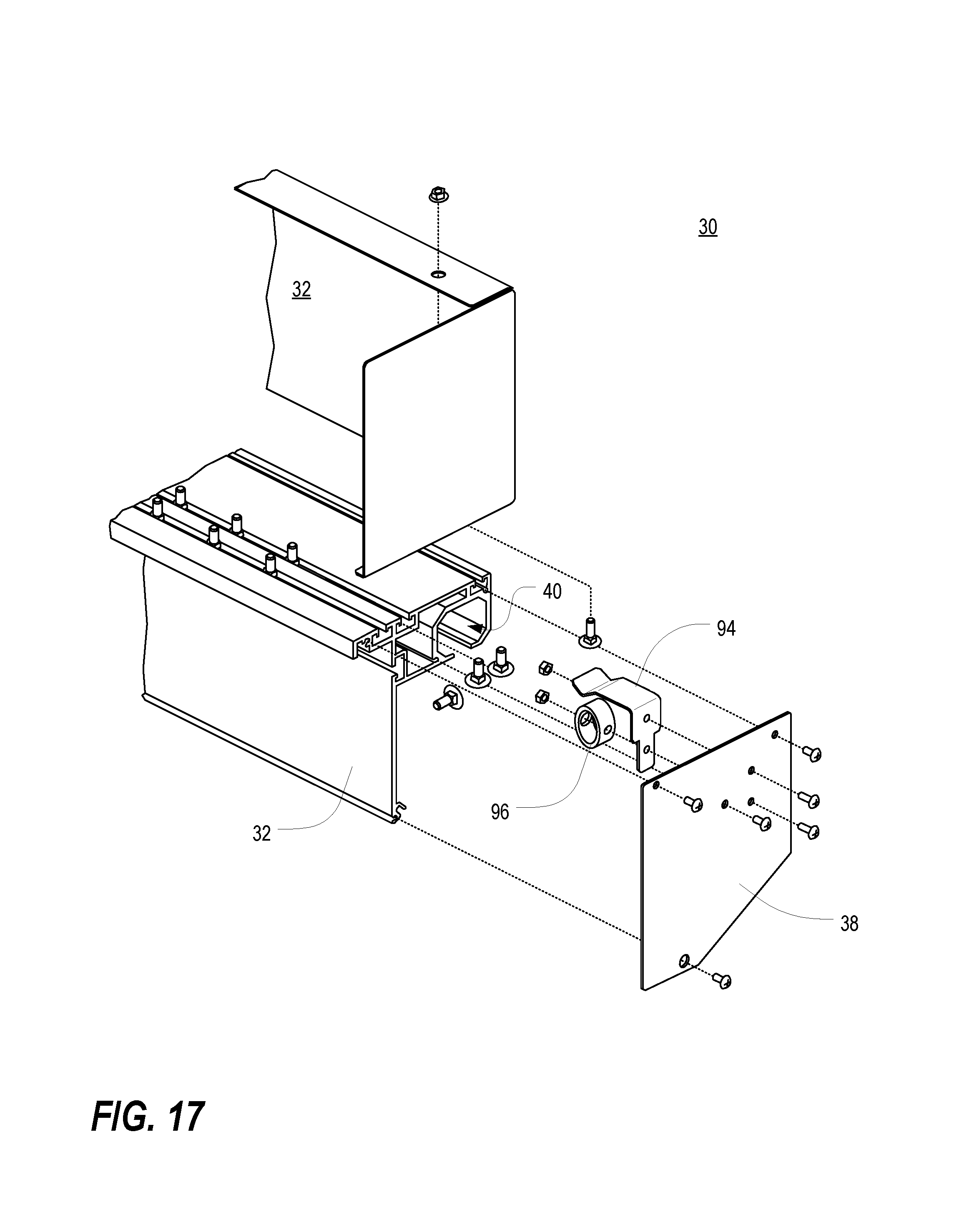
D00013
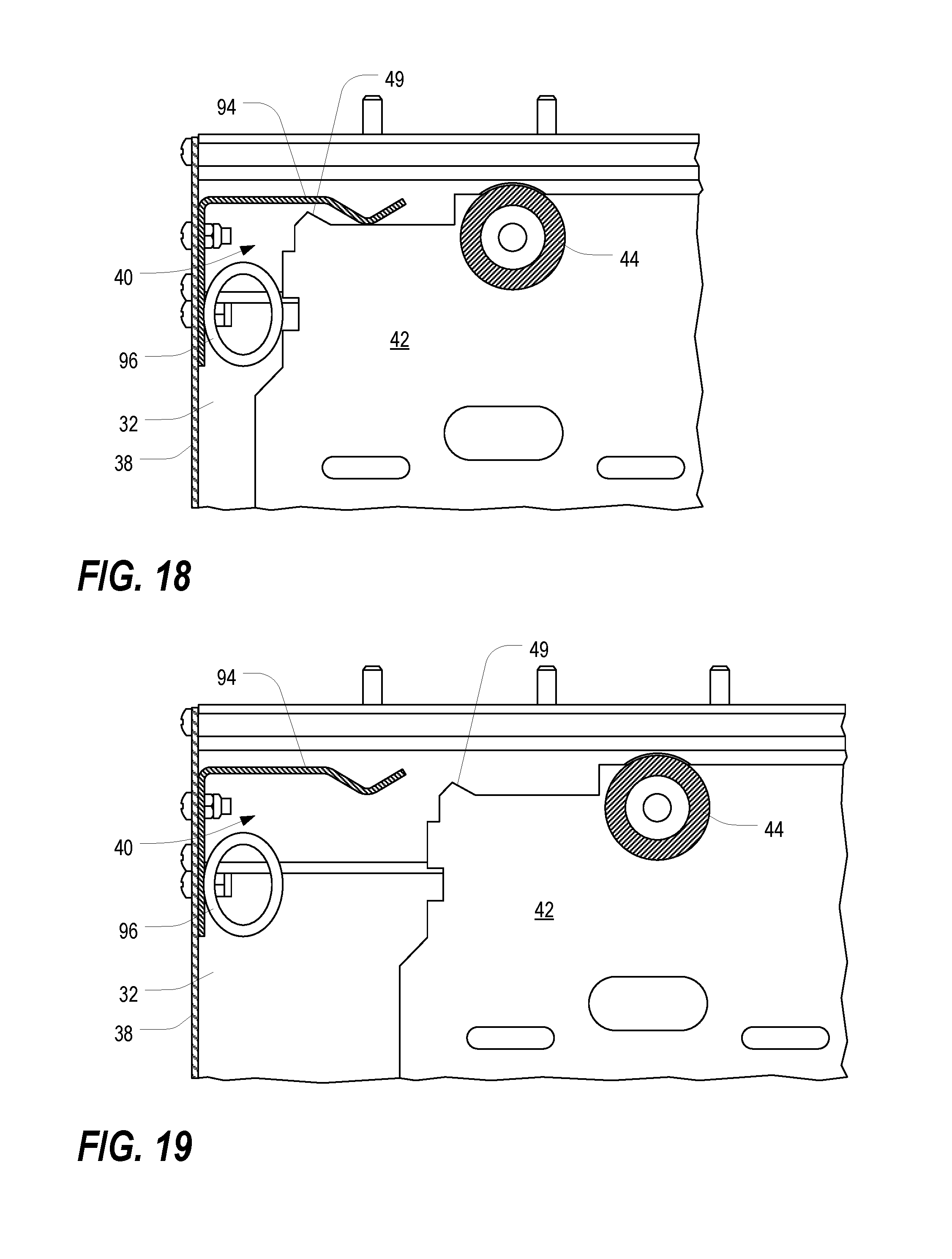
XML
uspto.report is an independent third-party trademark research tool that is not affiliated, endorsed, or sponsored by the United States Patent and Trademark Office (USPTO) or any other governmental organization. The information provided by uspto.report is based on publicly available data at the time of writing and is intended for informational purposes only.
While we strive to provide accurate and up-to-date information, we do not guarantee the accuracy, completeness, reliability, or suitability of the information displayed on this site. The use of this site is at your own risk. Any reliance you place on such information is therefore strictly at your own risk.
All official trademark data, including owner information, should be verified by visiting the official USPTO website at www.uspto.gov. This site is not intended to replace professional legal advice and should not be used as a substitute for consulting with a legal professional who is knowledgeable about trademark law.